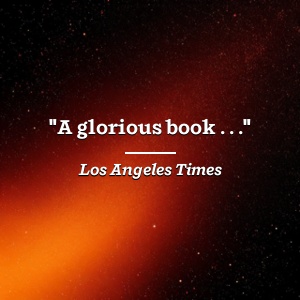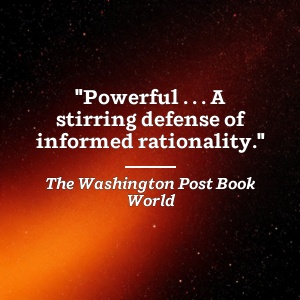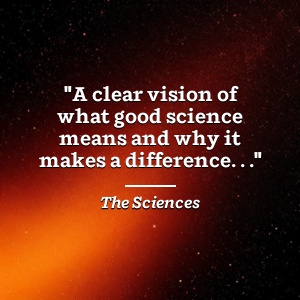معلومات عنا
حقوق الطبع والنشر © 2024 Desertcart Holdings Limited


The Demon-Haunted World: Science as a Candle in the Dark



S**R
a buoyant book brimming with the sagacity and soundness of judgment of the late, great Carl Sagan
In a world of ungrounded thought, I feel comforted by Sagan's sagely, skeptical words. "Skepticism doesn't sell newspapers," he explains. He was heavily pro-science and upset about America's scientific illiteracy which fawns over fables and eschews facts. In this book, he takes no prisions from Atlantis and Lemuria, New Age pseudoscience, religious doctrinaire that attempts to validate themselves through prophecy, weeping paintings of the Madonna, Jesus' face on tortillas, fortune tellers (that btw target young women), psychics and channels including Ramtha, amulets, exorcisms, psychic surgery, witches, ghosts, flying saucers, astrology, reliance on prayer and miraculous healing, contradictory platitudes, and spiritual justifications for nearly any action."Some portion of the decision-making that influences the future of our civilization is plainly in the hands of charlantans," Sagan writes. "When we are self indulgent and uncritical, when we confuse hopes and facts, we slide into pseudoscience and superstition."Carl Sagan's question for a possible extraterrestrial was, "Please provide a short proof of Fermat's Last Theorem.""How is it, I ask myself, that UFO occupants are so bound to fashionable or urgent concerns on this planet? Why not even an incidental warning about CFCs and oxone depletion in the 1950s, or about the AHIV virus in the 1979s, when it might have really done some good?"Sagan thoroughly elucidates the most common strategies used to defend perilous fallacies of logic and rhetoric.In this book, he includes some history of the founding father's of the U.S. who were "realistic and practical, wrote their own speeches, and were motivated by high principles." He also uses examples of leaders and events in Europe, Russia, and China, and how they thought in ways that were superior to the dreck we have spiraled down to. He admires Jefferson's response to the Sedition Act and Linus Pauling's stance against nuclear weapons and involvement in the Limited Test Ban Treaty of 1963. Sagan himself took an anti-nuclear stance.Carl Sagan wisely implores us to question everything our leaders tell us."One of the saddest lessons of history is this: If we’ve been bamboozled long enough, we tend to reject any evidence of the bamboozle. We’re no longer interested in finding out the truth. The bamboozle has captured us. It’s simply too painful to acknowledge, even to ourselves, that we’ve been taken. Once you give a charlatan power over you, you almost never get it back."As far as Sagan's brief mention of drugs used for certain DSM diagnosis, the expert I defer to in that realm is Robert Whitaker and his book "Mad in America: Bad Science, Bad Medicine, and the Enduring Mistreatment of the Mentally Ill."I read portions of Sagan's book over again, and skimmed a few parts that seemed a bit repetitive. Overall, a very worthy read that I give a strong five stars.
S**D
Amazing, inspiring wonder, and dread
I can not praise this book enough, nor can I recommend it more highly.Dr. Sagan, through Cosmos, was a childhood hero, effortlessly explaining the infinite complexity out the Universe, in simple terms.He writes in the same manner, using language that is simple, effective and beautiful.The chapter on Baloney detection should be an educational course, taught at every level so students re learn it multiple things during school years.Despite it's readability and the amount of knowledge the book imparts, what I enjoyed most is that the book equips me. It provides tools and techniques to be more aware of myself, my fellow humans, and the world we exist in.It defines a responsibility reach and everyone of us should take; to process information better. That also scares me. For one, it lays out, in grim detail, where the human race has failed to do so, and subsequently, failed itself. Secondly, the human condition dictates that, at some point, each and everyone of us will fail to process information correctly.Thinking well is a life long struggle, and an individually responsibility. I hope we are up for it.Highly recommended.I wish Dr. Sagan were still alive; to hear him speak world be incredible.
A**R
Required reading for everyone
Great book with an important story to tell. Loved itThis is insightful and forces the reader to examine our Demon haunted world
H**X
How to think critically.
Carl Sagan (1934 – 1996) was an American astronomer, cosmologist, astrophysicist, astrobiologist, author, science popularizer, and science communicator in astronomy and other natural sciences. He published more than 600 scientific papers and articles and was author, co-author or editor of more than 20 books, a lot of them translated in different languages.Besides his ability to convey his ideas and vast scientific knowledge to laymen, I admire his scientific skepticism and methodology.His book “The Demon-Haunted World. Science as a Candle in the Dark” most have shocked a lot of people. Sagan wrote this book over twenty years ago now, but its relevance today is uncanny and scary. He is very critical about pseudoscience, the lack of skepticism, superstition, and the influence of religion on scientific research (the literal Bible beliefs). Sagan examines and authoritatively debunks such celebrated fallacies of the past as witchcraft, faith healing, demons, and UFOs.Especially lack of scientific education, the superstition and the religious narrow-mindedness of the average American are the major topic in this book. Sagan states early on in the book that "some 95 percent of Americans are scientifically illiterate."Some quotes:- “Nearly half of all Americans believe there is such a thing as psychic or spiritual healing.”- “For 200 years Americans have prided themselves on being a practical, pragmatic, nonideological people. And yet anthropological and psychological pseudoscience has flourished in the United States— on race, for example. Under the guise of “creationism,” a serious effort continues to be made to prevent evolutionary theory— the most powerful integrating idea in all of biology, and essential for other sciences ranging from astronomy to anthropology— from being taught in the schools.”- Charles Carroll’s The Negro a Beast (St. Louis: American Book and Bible House) taught its pious readers that “the Bible and Divine Revelation, as well as reason, all teach that the Negro is not human.” This book is still available an on sale on Amazon!- In October 1992 the NASA initiated by far the most promising, powerful, and comprehensive search for extraterrestrial intelligence (SETI). Just one year later, Congress pulled the plug. SETI was not of pressing importance; its interest was limited; it was too expensive. But every civilization in human history has devoted some of its resources to investigating deep questions about the Universe, and it’s hard to think of a deeper one than whether we are alone. […] Far from being narrowly based, the SETI program, strongly supported by the scientific community, is also embedded in popular culture. The fascination with this enterprise is broad and enduring, and for very good reason. And far from being too expensive, the program would have cost about one attack helicopter per year.Sagan is particularly on target with regard to politics. He states that the USA has national candidates now willing to say and espouse anything no matter how outrageous, provoking, or hateful. He warns about such despicable behavior and its effect on national decisions.In a nutshell: Carl Sagan’s “The Demon-Haunted World. Science as a Candle in the Dark” is a great book on how to think critically. Some zealots (not necessarily religious ones) may get offended. A little repetitive about UFOs, though.
ترست بايلوت
منذ أسبوعين
منذ شهر